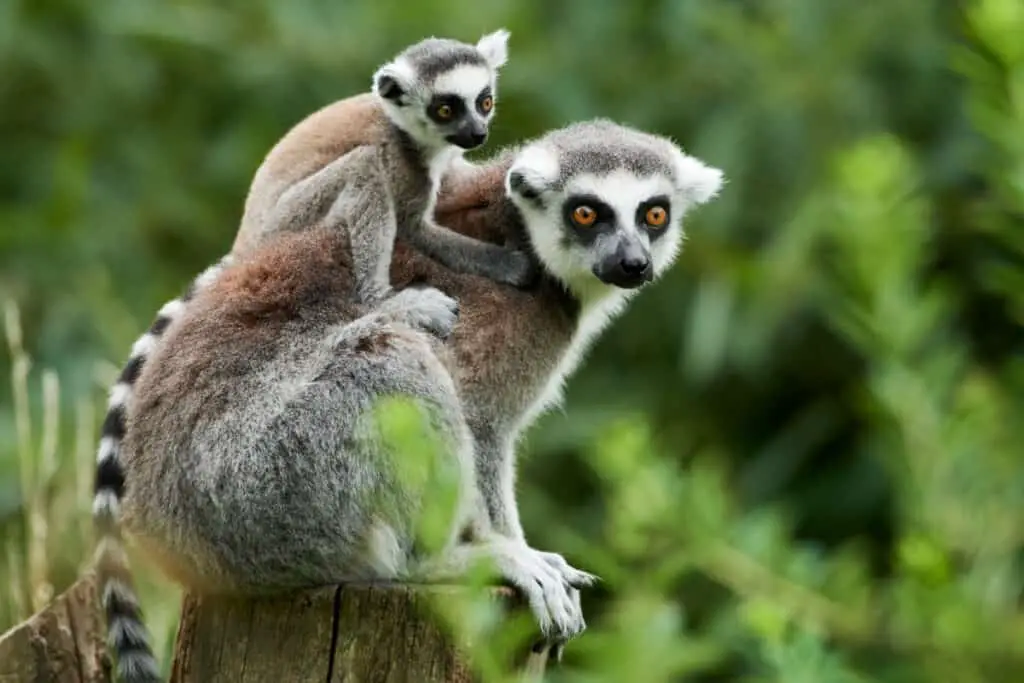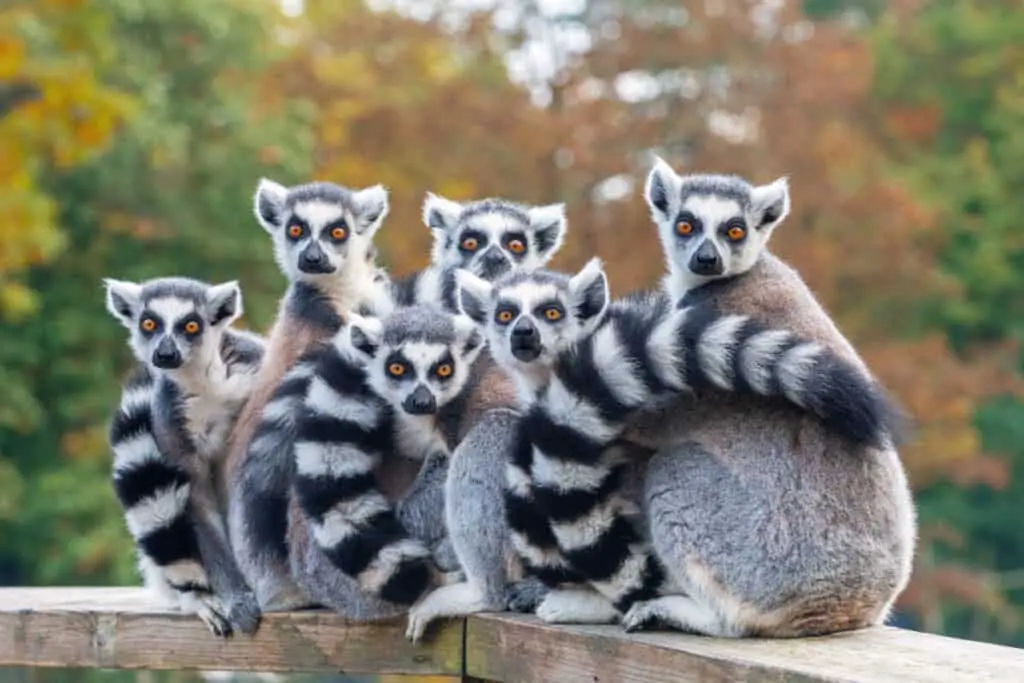Lemurs are a diverse group of primates found only on the island of Madagascar. They represent one of the most unique and intriguing mammalian radiations in evolutionary history, occupying a wide range of ecological niches and displaying an incredible diversity in morphology, behavior, and social systems.
Despite their fascinating adaptations and importance to the ecology of Madagascar, lemurs face numerous threats to their survival including habitat destruction, hunting, and climate change.
The first lemurs appeared on Madagascar around 60 million years ago after crossing over from Africa by rafting across the Mozambique Channel. Since then they have diversified into more than 100 different species that occupy all levels of the forest canopy as well as some open habitats like spiny forests or savannas.
Lemurs’ size varies tremendously among different species with smallest ones weighing less than 30 grams while largest reaching up to 10 kg. Social organization ranges from solitary individuals to large groups where females dominate males in hierarchy. Some lemur populations also exhibit female-female sexual behavior – a rare phenomenon called “female homosexuality”.
The high degree of endemism coupled with alarming rates of deforestation makes many lemur species highly endangered today.

Lemur Evolution And Origins
Lemurs are primates endemic to Madagascar and the Comoro Islands. They are considered one of the most ancestral groups of living primates, with a rich evolutionary history dating back at least 62 million years ago.
Phylogenetic analysis has shown that lemurs diverged from other primates early in their evolution, prior to the divergence between monkeys and apes around 40 million years ago.
Genetic divergence within lemur species is high due to their isolation on Madagascar and limited gene flow between populations. This has resulted in a remarkable diversity of over 100 extant lemur species, ranging from tiny mouse lemurs weighing less than an ounce to large indriids weighing up to 22 pounds.
The unique ecological conditions on Madagascar have also contributed to the evolution of many unusual traits among lemurs, such as specialized dental adaptations for feeding on bamboo or sifakas’ ability to leap up to ten meters through trees.
Despite their long history and diverse morphology, however, all lemurs share a suite of characteristics that distinguish them from other primates, including distinctive grooming habits, seasonal breeding patterns, and reliance on olfactory communication.
Ring-Tailed Lemurs and Their Predators: Unmasking the Threats
Lemur Diversity In Morphology And Behavior
Lemurs are a diverse group of primates that exhibit a wide range of morphological adaptations and behavioral diversity. They are found exclusively on the island of Madagascar, where they have evolved in isolation for millions of years.
The unique environment presented by this isolated landmass has resulted in lemurs developing an array of specialized traits to help them survive. Morphological adaptations among lemurs include elongated limbs, opposable digits, and highly sensitive fingertips. These features allow them to efficiently navigate their arboreal habitat and locate food sources such as fruits and leaves.
Behavioral diversity is also evident among different species of lemurs; some prefer to live solitary lives while others form complex social groups with intricate hierarchies. Lemur communication involves vocalizations, scent marking, and body language, all utilized for purposes ranging from warning others about predators to attracting mates during breeding season.
Overall, the wide range of morphological adaptations and behavioral diversity exhibited by lemurs highlights the importance of studying these animals in order to better understand how evolution works on isolated islands like Madagascar.
Ecological Niches Of Lemurs In Madagascar
Lemur species in Madagascar have adapted to a variety of ecological niches over the course of their evolution. These adaptations are largely driven by habitat preferences and feeding strategies. Understanding these factors is essential for effective conservation management.
Firstly, lemurs exhibit diverse habitat preferences ranging from rainforests, dry forests, spiny forests, mangroves, and high-altitude ecosystems. Each of these habitats provides unique resources that certain lemur species rely on for survival. For instance, bamboo lemur (Hapalemur griseus) thrives in bamboo-rich forest patches while sifakas (Propithecus spp.) occupy cathedral-like canopies within primary rainforest ecosystems.
In addition to habitat preferences, lemurs also utilize different feeding strategies such as folivory or frugivory depending on the availability of food sources in their respective habitats. To further illustrate this point, here are some examples showing how various lemur species have specialized feeding habits and habitat preferences:
- Ring-tailed Lemurs prefer open areas with sparse vegetation where they can easily forage on grasses and herbaceous plants.
- Aye-ayes inhabit mature moist tropical forests but specialize in utilizing dead wood since they feed primarily on insect larvae found inside tree trunks.
- Red Ruffed Lemurs live exclusively in the canopy layer of rainforests and eat mostly fruit along with leaves when fruits become scarce.
- Mouse Lemurs inhabit dense undergrowth littered with leafy debris where they hunt insects at night using their excellent sense of smell.
As a result, it is important to consider both habitat preference and feeding strategy when designing conservation efforts aimed at protecting lemurs in Madagascar’s fragile ecosystems. By understanding these crucial components of lemur ecology we can ensure our interventions do not inadvertently harm specific populations or cause unintended consequences for other coexisting wildlife.
Curious about Aye-Ayes’ Senses? Let’s Explore How Good They Are!
Threats To Lemur Survival
Lemurs are facing numerous threats to their survival, with habitat loss being one of the main issues.
The destruction and degradation of forests due to human activity such as logging, mining, and slash-and-burn agriculture has led to a significant decline in lemur populations.
Many lemurs require specific forest types for food and shelter, making them particularly vulnerable when their habitats are destroyed or fragmented.
Another major threat to lemurs is poaching.
Lemurs have long been hunted for bushmeat and traditional medicine in Madagascar, where they are endemic.
This illegal trade not only results in direct harm to individual animals but also disrupts social structures within lemur communities.
Additionally, some species are captured for the pet trade both domestically and internationally, further contributing to declines in wild populations.
These combined threats make conservation efforts even more important for the future survival of all lemur species.
The protection of lemur habitats from deforestation and other forms of development must be prioritized if we hope to conserve these unique primates.
Alongside this effort, increased enforcement against poaching is necessary in order to reduce demand for lemur products on local markets.
As many lemurs inhabit protected areas that often lack sufficient resources for effective management, community-based approaches may prove valuable by engaging local people in conservation efforts while providing alternative livelihoods that do not rely on extraction from natural resources.
Ultimately, it will take a concerted effort at multiple levels – national policies, international cooperation, and grassroots initiatives – to ensure that our closest relatives survive into the future without becoming extinct like so many other primate species before them.

Social Systems Of Lemurs
Lemurs are social animals that live in groups called troops, which can range from a few individuals up to 30 or more.
Within these troops, there is a clear dominance hierarchy where certain individuals hold higher ranks than others. The top-ranking lemur has the first choice of food and mate selection while lower-ranking individuals must wait their turn.
Communication methods among lemurs vary depending on the species but commonly include vocalizations such as calls and songs, scent marking using glands located around their body, and visual displays like tail flicking and posturing. These communication methods help establish territory boundaries, locate potential mates, warn others of danger, and maintain group cohesion.
It’s also been observed that some species use facial expressions to communicate emotions with one another.
To better understand the social systems of lemurs, it’s important to note that not all species exhibit the same behavior patterns. Some have more complex social structures than others and may even form temporary associations with other nearby troops during mating season.
Additionally, research has shown that the presence of humans near lemur habitats can disrupt their communication methods and cause stress within the troop dynamic. Therefore, conservation efforts should prioritize minimizing human impact on these delicate ecosystems to ensure healthy lemur populations for years to come.
Endangered Lemur Species And Conservation Efforts
The social systems of lemurs are fascinating and complex, with each species exhibiting unique behaviors and structures.
However, despite their intriguing characteristics, many lemur species face serious threats to their survival. Human impact has been a major factor contributing to the endangerment of these primates. Habitat destruction due to deforestation for agriculture and logging activities has greatly reduced available habitat for lemurs.
Conservation strategies have been implemented in an effort to protect endangered lemur species from extinction. One approach is the creation of protected areas such as national parks and reserves where human activity is restricted or prohibited altogether.
Furthermore, efforts have been made to raise awareness about the importance of protecting lemurs through educational programs aimed at local communities and tourists. Additionally, some conservation organizations work directly with local communities on alternative income-generating activities that do not rely on forest resources, thereby reducing pressures on lemur habitats.
These measures aim to mitigate the negative impacts humans have had on lemur populations and secure their long-term survival in the wild.
Conclusion
Lemurs are a fascinating group of primates found only in Madagascar. Their unique evolutionary history and diverse morphology and behavior have captivated researchers for decades.
However, the survival of these creatures is under threat due to habitat destruction, hunting, and other human activities.
Despite the challenges they face, lemurs continue to exhibit complex social systems and occupy various ecological niches on the island.
Conservation efforts are underway to protect endangered species and their habitats, but much work remains to be done.
As we consider the plight of these remarkable animals, we must recognize our responsibility as stewards of this planet. The fate of lemurs serves as a powerful reminder that every action we take has consequences – not just for ourselves but for all living beings who share this world with us.
Let us strive towards a future where humans live in harmony with nature, so that generations to come may also marvel at the beauty and wonder of creatures like lemurs.

